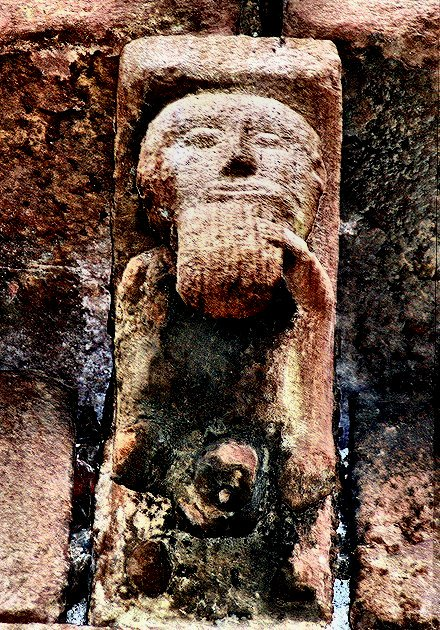An Egyptian Bronze Figure of Osiris, 21st/26th Dynasty, 1075-525 BC.
Why does Osiris wear "braided", "plaited" false beard?
Remember my post "Sphinx" about this 2,800 year old ivory was recently discovered in the old Hittite capital Hattusa, Turkey and the Sphinx as a Deified Lion animal calendar marker?
And do you remember the followup post "Giza lioness" about the Queen Hetepheres II sphinx from the Cairo Museum and the meaning of the part of the Egyptian creation myth that says that: "...lion emerged from the primeval mass within the primeval waters before all other animals, and mankind"?
Well in that post I talked about the importance of the fact that the Great sphinx originally had "a long braided ‘divine beard’...that gods and deified kings wore, and not a short, square beard worn by living kings"...
And then I said "This is the same beard worn by Osiris, the god of resurrection directly linked to the annual flood..." I talked about this beard and its meaning in my post "The beard of Osiris". I also talked about Pharaohs who wore a false beard to pretend to be Osiris (who wore a false beard to pretend to be a dead ancestor 🙂) and about the cult of the dead in Ancient Egypt. Grain growing from the body of Osiris.
When I posted the link to this article on Facebook yesterday, a friend of mine asked me a very interesting question:
"A puna šaka brade?" (What about the expression "hand full of beard"?)
The "puna šaka brade" (hand full of beard) is an expression from Serbo-Croatian which means "big gain, big fortune, big happiness, big satisfaction"...
In this article (in Serbian) the author argues that the expression comes from the fact that "rubbing one's chin, or stroking one's beard is a natural expression of satisfaction"...
I've seen old people doing this so many times all over the Balkans...And now I am one of the "old people" stroking my beard as a sign of great satisfaction that I had stumbled across another interesting "syncretism" 🙂
In my post about the fake beard of Osiris, I talked about the Egyptian cult of the dead, and the cult of the dead in general, and how the dead ancestors, represented by the guys with long beards, were linked to grain agriculture and grain fertility...
Now remember my post "Wheat cross" about "wheat cross" decorated with "wheat wreath" harvest traditions from Central Europe?
In it I said that the wheat wreath was always made by women, and was made "the way you would plait women's hair"...
Which (thank you @another_barbara) looks like ear of wheat...
Which means that the girl carrying the wheat wreath was the embodiment of the Grain/Wheat/Corn Maiden...
Now this is what real plaited, braided beard actually looks like. It also looks like ear of grain...Very fitting as a symbol of Osiris, the god of the fertile black soil from which grain grows...
So is this why the (false) beard of Osiris and Deified Pharaohs (Deified Ancestors) is plaited? To look like grain growing out of the (grateful) dead?
Diduch (grandfather), symbolic representation of the ancestral spirit which governs the lives of the living.
From Central European Slavic mythology / folklore. More in my post "Diduch"...
I talked about the importance of keeping the dead happy if you wanted your grain to grow in my post "Care of the dead"...
Remember this depressed dude? This is the statue of the Last Hittite king Suppiluliuma II. And he said: "...humiliation of the Hittite kingdom is the result of the fact that the Hittites have forgotten to respect the sacred bond with their dead..."
Maybe Osiris wore "grain beard". Or maybe this is all just a coincidence...And this has nothing to do with anything: The last harvested sheaf of wheat was in the past in some parts of Serbia used to make "Velesova brada"(The beard of Veles, Slavic sun/summer/harvest god) or just Božija brada (God's beard)...
The "grain spirit" is in European folklore usually preserved as female "corn dolly" made from the last harvested sheaf of wheat. I talked about this in my post "Corn dolly" and "The old woman of the mill dust"...
The spirit of the "Mother of Grain" (Mother Earth). After all grain grows from earth...
I talked about this in my post "Mother of grain"...Grain seed and vulva symbolism...Link between female fertility and earth/grain field fertility...
But did (some weird) Serbs, just like (weird) Ancient Egyptians, associate the grain fertility with a male god...And hence preserved the "grain spirit" in the male God's beard?
Again, let me remind you of this
Serbs, like all the other Balkan people, are descendants of pretty much everyone who ever lived in the Balkans...Which is why, I thought then, and still think, we can find so many interesting bits of many old lores in Serbian folklore...
There is of course another possibility. A long beard, means long life...In the past, in the Balkans, men had long life only if they were fucking lucky...
This is Serbian gusle player and epic poems singer Rajko Ivković. Born in 1880, in the village Gradovi on mountain Rudnik in Serbia. Survived 3 wars. Had many stories to tell. The word history deep down means "what old people saw". From my post "History"...
Anyway, speaking of "stroking ones beard as a natural expression of satisfaction" 🙂 Remember my post "Sceptre"?
Church decoration, Mansilla de la Sierra, Spain.
Serbian expression "he acts as if he pulled god's beard", which means "he acts like god gave him power", has another version "he acts as if he pulled god's penis".
I hope you liked this. Have a nice evening 🙂 And "May your beards grow long". Unless you are a woman of course.



















No comments:
Post a Comment